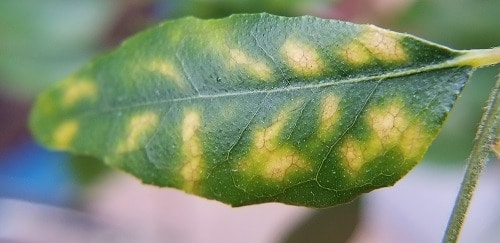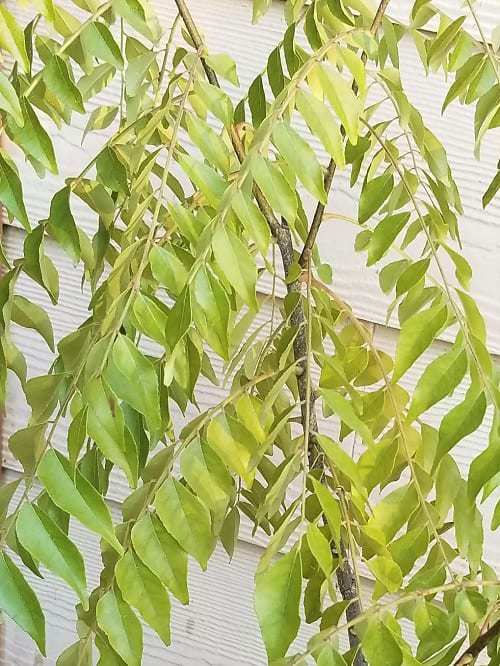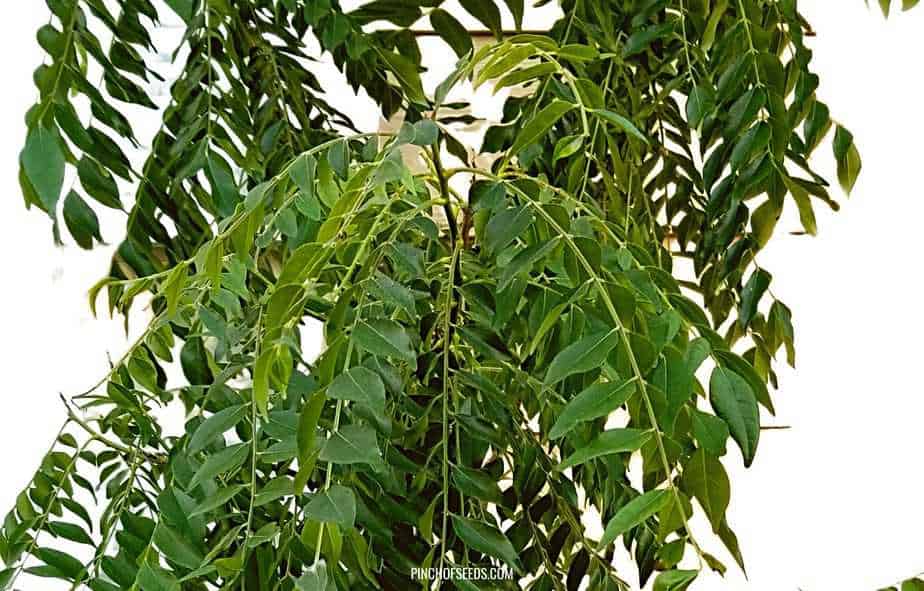Without a doubt, a Curry Leaf Plant is the most precious plant in any Indian kitchen garden. All of us want our curry leaf plant which is also known as ‘Kadi Patta’ to grow faster, bushier, and greener than what it is. Most of the readers of the article How to Transplant a Curry Leaf Plant ask me three questions: How do I grow curry leaves faster? How do I fertilize a curry leaf plant? And what is the best natural fertilizer for the Curry leaf plant? Well, let me share a secret with you: most of the fertilizers for your Curry leaf plant can be homemade, right in your kitchen!
How to Fertilize Curry Leaf Plant: Curry leaf plant benefits significantly from regular feedings of fertilizers higher in Nitrogen (N) value. Apply one application of Blood Meal in the spring, followed by monthly applications of Seaweed or Fish fertilizer. Curry Leaf plant also responds positively to homemade fertilizers like Buttermilk, Rice water, Asafoetida, and eggshells, which can be applied weekly.
Curry Leaf Plant growing in-ground doesn’t require a lot of fertilizers. It gets most of the nutrients and minerals from the soil. When growing in a container, the nutrients and minerals from potting soil wash away with the regular watering. That’s why you should follow a fertilizer schedule to make your curry leaf plant healthier, bushier, and grow faster.

Let’s review the best fertilizer options for the Curry leaf plant, how they help the curry leaf plant, and how to apply them.
Best Homemade Fertilizers for Curry Leaf Plant:
Buttermilk
Is buttermilk good for curry leaf plant? Yes, there are multiple reasons why buttermilk is an excellent homemade fertilizer for a curry leaf plant. Buttermilk is high in Nitrogen, which curry leaf plant needs. Buttermilk makes the soil acidic, which curry leaf plant loves. Lastly, buttermilk contains probiotic bacteria, which not only increases the soil’s microbe level but also helps the curry leaf plant fight the fungal infections like black spots and powdery mildew.
How to Apply:
– Let the soil of the container dry out a little before the buttermilk application.
– Mix 2 tablespoons of sour yogurt or curd into 1 gallon of water.
– Pour the mixture at the base of the curry leaf plant.
– Apply weekly.
Rice Water
Why: For many generations, gardeners in India give washed rice liquid to the curry leaf plant. It is believed that the unpolished rice contains a high level of Vitamin B, which may stimulate new root growth. Some scientific views prove otherwise, but it wouldn’t hurt to try and find out for yourself!
How to Apply:
– When washing white or brown rice for cooking, save the water.
– Pour the water at the base of the curry leaf plant.
– Can apply rice water instead of regular watering.
Asafoetida
Why: Asafoetida (AKA ‘Hing’) promotes new top shoots and baby leaves on the curry leaf plants. Although there is no scientific research supporting this belief, many gardeners use Asafoetida as a growth stimulant for curry leaf plants and are happy with the results. For better results, apply Asafoetida together with the buttermilk mixture.
How to Apply:
– Prepare the buttermilk mixture, as described above.
– Add ¼ teaspoon of powdered Asafoetida into the mixture.
– Mix well.
– Pour the mixture at the base of the curry leaf plant.

Eggshells
Why: Crushed eggshell provides Calcium- one of the critical nutrients for the plant’s well-being. Calcium promotes vigorous growth as well as green foliage and a robust root system. No wonder eggshells are one of the best homemade fertilizers for curry leaf plant!
How to Apply:
– Save 2 to 3 eggshells in a Ziplock bag.
– Crush the eggshells. Sprinkle the eggshells on the surface of the soil.
– Mix the top 1” to 2” of soil carefully, making sure not to damage the roots.
– Can be applied every 2 to 3 weeks.


Best Natural and Organic Fertilizers for Curry Leaf Plant:
Homemade fertilizers are good for curry leaf plant, but they are not enough by themselves. You should apply at least one of the liquid fertilizer (for quick drink of nutrients) and one of the granular/solid fertilizer (for long term feeding) from the list below for optimum growth of the curry leaf plant.
Fish Emulsion and Fish fertilizer
Why: Curry leaf plant is mainly harvested for its leaves. To grow lush green leaves, curry leaf plant needs more amount of Nitrogen. Fish emulsion is an organic, liquid fertilizer which has high Nitrogen value but also contains some amount of Phosphorus and Potassium. Most of the fish emulsion fertilizers like Alaska Fish fertilizer has a nutrition value of 5-1-1. Fish fertilizers also contain many trace minerals that are beneficial to most of the plants in any garden. Liquid fertilizers like the Fish emulsion are readily available for the plants to be absorbed and thus provides quicker results than granular fertilizers.
How to Apply:
– Follow the direction on the product label.
– If no clear direction provided, mix 2 tablespoons of the product with 1 gallon of water.
– Pour at the base of the curry leaf plant.
– It can be used as a foliar application -Spray on top and bottom of the leaves.
– Make sure to apply outside as the Fish products smell pretty bad.
– Apply every other week; skip when any additional fertilizer is applied in the last 4-6 days.
Seaweed Fertilizer
Why: If you want to make your curry leaf plant grow faster, apply seaweed fertilizer every 15 days. Seaweed or Kelp fertilizers contain more than 60 trace minerals from the ocean. Not only that, but they are also valuable as a growth stimulant because of the presence of multiple growth hormones. These fertilizers are available in liquid as well as in powder forms.
Seaweed is a plant-based, organic fertilizer option for the vegetarian or vegan growers who do not want to apply any animal-based fertilizers to their curry leaf plants.
To fertilize my curry leaf plant, I use Neptune’s Harvest Seaweed and Fish fertilizer. It not only has growth stimulants from Seaweed but has the goodness of fish fertilizer as well. Best of both worlds! This can be used for fertilizing seedlings as well as fertilizing tomatoes growing in the garden.
How to Apply:
– Follow the direction on the product label.
– If no clear direction provided, mix 2 tablespoons of the product with 1 gallon of water.
– Pour at the base of the curry leaf plant.
– It can be used as a foliar application -Spray on top and bottom of the leaves.
– Apply every other week; skip when any additional fertilizer is applied in the last 4-6 days.
Blood Meal
Why: Blood meal has about 10 to 12% of Nitrogen, which helps curry leaf plants grow more leaves. Blood meal takes a few weeks to break down. So, it is best to supplement it with liquid fertilizers to provide both long term nourishment and quickly accessible nutrients for the optimum growth of the curry leaf plant.
How to Apply:
– In early spring, add 1 tablespoon of blood meal to the potting soil (for 14” diameter pot); add proportionately more for a larger pot.
– Mix the top layer of soil gently, without damaging the roots.
– Water thoroughly.
Cow Manure:
Why: While providing key nutrients to the Curry leaf plant, cow manure also helps improve the soil structure. It makes the compact and heavy clay soil loose for easier root penetration. Plus, it also helps in retaining water in the potting soil. Make sure the cow manure is properly ‘baked’ or dehydrated, otherwise it can burn the curry leaf plant.
How to Apply:
– Add a trowel full of manure to the potting soil (for 14” diameter pot); add proportionately more for a larger pot.
– Mix the top layer of soil gently, without damaging the roots.
– Water thoroughly. It can be reapplied mid-season.
– Do not apply to a curry leaf plant that is less than 1 year old- it can burn the plant.
Additional Nutrients for Curry Leaf Plant:
In addition to the fertilizers, which provides the essential nutrients (N-P-K), Curry leaf plant needs three supplemental nutrients- Iron, Magnesium, and Calcium. Here is why and how to apply them:
Chelated Iron

Why: Curry leaf plants are known to be Iron deficient quite frequently. You will know if your curry leaf plant needs Iron if the leaves of the plant turn yellow, but the veins of the leaves stay green. One of the reasons for Iron deficiency is the higher Ph level of the soil. Curry leaf plant loves acidic soil, so maintain the Soil Ph between 6.4 to 6.9.
Chelated Iron is an altered form of Iron that is easier for the plants to absorb and digest. Thus showing quicker results than the powdered Iron.
How to Apply:
– Follow the product label for direction.
– It can be applied as soil saturation or as a foliar spray.
– Apply every three months if also feeding the buttermilk solution Or apply every two months until early fall.
Epsom salt

Why: If your curry leaf plant is lacking the lush green color, or looks yellowish all over, it may have become Magnesium deficient. Epsom salt is a household name for ‘Magnesium Sulfate.’ It contains Magnesium and sulfur. Though by itself, Epsom salt is not a fertilizer, it provides essential nutrients to enhance the effect of fertilizers. Epsom salt helps plants increase chlorophyll production and helps restore the green color of the leaves.
How to Apply:
– Dissolve 2 Tablespoons of Epsom salt per 1 gallon of water.
– Pour the mixture gently at the base of the curry leaf plant.
– It can also be applied as a foliar spray- soak the leaves by spraying the solution directly on the leaves.
– Apply monthly until early fall.
Gypsum:
Why: Gypsum is an excellent source of Calcium, another critical nutrient that is essential for the overall growth and development of the curry leaf plant. It aids in root and leaf development.
How to Apply:
– Follow the product direction
– Spread Gypsum on top of the potting soil.
– Mix the top layer of soil gently, without damaging the roots. Water thoroughly.
– Apply every other month. Do not overlap the application with Iron application.
Keep at least a one month gap between Iron application and Gypsum application.
Tips for Fertilizing Curry Leaf Plant for the best growth:
- For the best result, you should balance between solid (or granular) fertilizer and liquid fertilizers. Don’t overdo it. It is okay to underfeed the plant than over-fertilizing it.
- After pruning the curry leaf plant, wait for 2 to 3 weeks before fertilizing it.
- Stop fertilizing about a month before the plant needs to be moved inside for the winter.
- Apply fertilizers only during the growing season when the plant is outdoors. During the winter months, while indoors, Curry leaf plant doesn’t need fertilization.
- Apply foliar sprays on cool, cloudy days. Scorching sun can burn the leaves soaked by the foliar spray.
- Do not apply fish fertilizer when the plant is indoors. It will stink up the entire house.
- Water the plant regularly, but let the soil dry out slightly before applying fertilizer. A thirsty soil will soak up the nutrients faster than the water-saturated soil.
- Keep your pets away from the curry leaf plant for a few days after applying fertilizers. Some of the fertilizers have heavy smell of fish, bone and eggs. Your pet may get curious and start to dig the soil.
- Curry leaf plant can be infested with Scales, Aphids and ants. Use Neem Oil Insecticide which can also help in fighting black spots on the leaves.
Want to know more about growing a Curry Leaf Plant?
- How to care for a Curry Leaf Plant
- 3 Things to Consider Before Buying a Curry Leaf Plant
- How to Transplant a Curry Leaf Plant
- How to prune a curry leaf plant to make it bushy
Ask your questions:
If you have any question regarding growing curry leaf plant, please leave a comment below. Or connect with me on Pinch of seeds group on Facebook. You can ask questions, post a picture for photo consultation, get personalized response and interact with other gardeners.
Last updated: 9/14/2020


HI GOPI,
I AM FOND OF GARDANING, WHEN I WAS AT CONECTICUT I GROW SIX CURRY PLAN IN POT .
THEN I MOVED TO TEXAS WHERE I GROW CURRY PLANT IN GROUND, BUT RSENTLY IN THIS WINTER ALL MY PLANTS DIED.
PLEASE ADVISE HOW TO GET BACK.
MISS, GOPY I AM 77YEARS OLD I DO LOTSOF GARDANIG. I AM INDIAN FROM VADODRA.
THANKS
WITH BEST REGARDS
MAHENDRA 832-572-7888.
I
Hello Mahendrakaka!
Curry leaf plants do not tolerate freezing temperature. Most likely they die if exposed to temperature below 32F. But, before pulling out the curry leaf plants, make sure there is no life left in it. Try bending a stem. If it breaks easily, then the plant is dead. If it bends, but does not snap, it may come back to life after a few weeks. If the curry leaf plants are surely dead, it is best to start with a new plants. Given the Texas heat, they will grow into Curry leaf trees in just a few months!
Good luck!
– Gopi
Hi Gopi,
I enjoyed your article on the Kaddi patha plant.
My plant was doing well until several months ago when black splotches are now on the underside of all the leaves. Then the edges of the leaves turn brown. We have always used acidic fertilizer and have played around with the amount of watering to see if that could be the issue but no change. Could it be a fungus? The black does not rub off.
Any suggestions you may have or experience in this?
Thanks,
Archana
Hi Gopi,
We live in San Diego. Our curry plant was doing fine until the last 6mo or so I have noticed the underside of the leaves getting black splotches and then the edges of the leaves turn brown. Every leaf now is like this. We have always used an acidic fertilizer. We have tried different amounts of watering but there is no change. Could it be a fungus? The black does not rub off. Any suggestions are welcome.
Thanks,
Archana
Hello the leaves on my curry plant are getting small brown textured bumps on them. They sticky when I try to touch/wipe them off. The congregate at the base of the leaf where it is attached to the steam and fan out towards the tip of the leaf. How can I hp my curry leaf plant.
Hi Zeba!
It seems the curry leaves plant is infested by Scales. They are small little insects that sticks on the leaves and stems of a plant. You can apply neem oil to get rid of scale.
Hope this helps!
– Gopi
Hello Gopi,
I bought curry leaves stalk from the grocery and from the huge bunch stuck two in the soil more than 6 months ago, in summer. I live in Vancouver Canada. It is just taking roots (I think) because there ase small shoots on the top. I brought it in for winter. How do I increase its growth. It’s in a warm room, but the soil is still wet. Do you also have suggestions on increasingGrowth on Mogra plant which is 2years old and the shoots come and die – get dried out, also indoors for now.
Hello Gopi, I want to grow a curry leaf plant at home. Do you recommend I use seeds to grow the plant or buy a young plant and replant it?
Also, I live in Florida. Do curry leaf plants grow well in this state?
Thank you!
Urvashi
Hello Urvashi!
Curry leaf seeds need to be sown very soon (within a day or two) after harvesting from the plant. And it is VERY slow to germinate and grow in the beginning. Personally I would start with a young curry leaf plant rather than from seeds.
Since Florida has warm weather most of the year, it is perfect condition for the curry leaf plant. In fact, they thrive in this kind of humid and hot weather. You may be able to grow the curry plant directly in the ground and raised it to become a Curry leaf tree!
– Gopi
HI Gopi,
what major nutrients required for cutty leave plant, (N,P,K)
curry leaves.
Hi Chandu!
A curry leaves plant needs more Nitrogen (N) for growing green leaves and Phosphorous (P) for making strong root system. That being said, the importance of Potassium (K) should not be ignored for the over all health of the curry leaf plant.
-Gopi
Hi Gopi,
Can you please elaborate how to identify plant stage this is the right time to give phosphorus/potash/calcium fertilizer to the plant. So much confused… It’s very helpful to me.
Hi Suresh!
I think you are asking about the curry leaf plant. In general, the curry leaf plant should not be fertilized for the first 6 months or at least 6″ tall.
– Gopi
Hi Gopi,
Thanks for the detailed info I would like to keep in touch to share my experiences of how I get along with the curry plant. Do keep in touch
Hello,
I am glad you find the curry leaf plant care guide helpful!
-Gopi
Hi Gopi,
I just came across your website and much appreciate all the detailed pointers you have for curry plants. I live in N. California and grow my curry plants indoors. They had been doing well for the last couple years, but since the last 3-4 months, a lot of the leaves have turned yellow several with brown edges.. They are also liberally falling off the plants, often with the whole stem falling off. Clearly there is nutritional deficiency. Would greatly appreciate any tips on how I can resolve this problem. Thank you, in advance. Regards. Sia